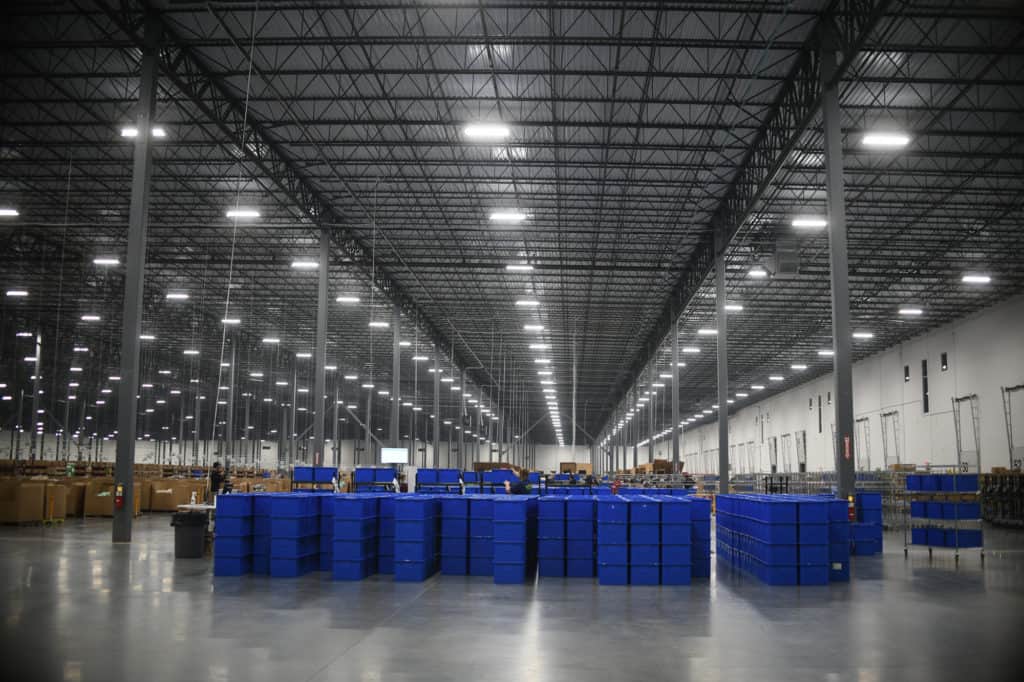Fewer than a third of supply chain management professionals view their collaborative processes as being “effective,” according to data from Flexis. It’s a troubling statistic, because as every supply chain manager knows, collaboration is crucial for a fully optimized supply chain. Supply chain optimization, however, is complex, encompassing everything from warehouse operational performance to logistics planning and more. From choosing the right logistics management software to perfecting the order fulfillment process, there are countless processes, steps and decisions that can have an impact on the supply chain.
We set out to demystify supply chain optimization by compiling a list of 50 expert tips and supply chain optimization examples you can put to use to improve supplier relationships, implement better QA best practices, increase your end-to-end visibility and more. By putting these expert tips, strategies, and supply chain optimization techniques into practice, you’ll be on the path to a more efficient, optimized supply chain.
- Building and maintaining relationships in your supply chain
- Important quality control tips
- Price negotiation strategies
- Ways to increase your end-to-end visibility
- Secondary and contingent supplier planning
Building and maintaining relationships in your supply chain
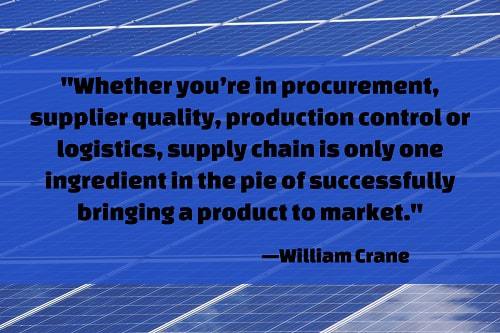
1. Keep in touch with cross-functional colleagues. “Whether you’re in procurement, supplier quality, production control or logistics, supply chain is only one ingredient in the pie of successfully bringing a product to market. Thus, developing robust personal and professional relationships with your colleagues in product development, engineering, manufacturing and finance will allow you and your team to be more effective.” —William Crane, 18 Tips for Supply Chain Professionals in 2018, Industry Star; Twitter: @industrystarllc
2. Put a spotlight on employee development. “Companies running supply chains face significant operational pressures every day; however, businesses still need to find the time to focus on developing employees and their skills. Companies can start doing this by regularly assessing their employees, investing in training and skills enhancement, rotating the most promising managers through multiple job assignments and spending time developing succession plans for higher level supply chain positions.” — Lloyd Smith, 5 Tips for Improving Your Supply Chain Management, Mindover Software; Twitter: @mindover_austin
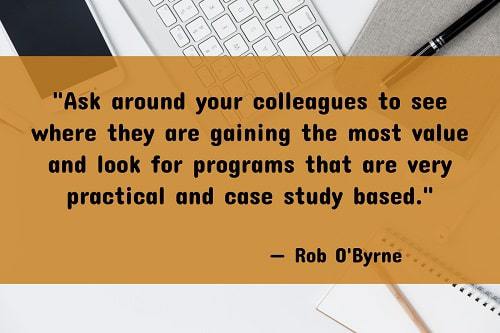
3. When it comes to supply chain optimization, invest in continuing training programs. “Many organizations these days just don’t have ‘spare’ resources to undertake operational reviews and implement improvements. So, it’s vital that those people you do have are well educated in how to identify Supply Chain issues and quickly come up with solutions to resolve them. Sometimes it’s hard to choose the right education and development programs for your teams, and the right combination of in-house v external. Ask around your colleagues to see where they are gaining the most value and look for programs that are very practical and case study based.” — Rob O’Byrne, Tips to Boost Supply Chain Performance, Logistics Bureau; Twitter: @LogisticsBureau
4. Focus on direct communication. “The nature of supply chains means that there can be a lot of players working on one project, and sub-contractors can often be left out of the loop when it comes to communication. Whether you’re the client or a contractor within a pipeline of work, it’s your responsibility to ensure clear communication comes through you.” — Anna Isaac, How to Manage Your Supply Chain, The Telegraph; Twitter: @Telegraph

5. Provide educational opportunities to analytics professionals. “Many supply chain companies are hiring analytics professionals to help implement these systems into their organizations. Though experts in their field, it’s important for these trained analytics professionals to learn about all aspects of your business. This business knowledge creates an open relationship between the business and the analytics, creating more opportunities for the numbers to aid in the processes.” — Adam Robinson, Marketing Strategist for Cerasis, 5 Tips for Achieving the Most Out of Your Supply Chain Data; Twitter: @Cerasis
6. Foster your relationships for better supply chain optimization. “The relationships between your organization and suppliers, and also between your supply chain management team and the rest of the stakeholders within your organization, are a key factor in building and maintaining a strong supply chain. Strong relationships require transparency on both sides and always aim to be mutually beneficial.” — 7 Tips for Building a Robust Supply Chain, Thomas; Twitter: @ThomasNet
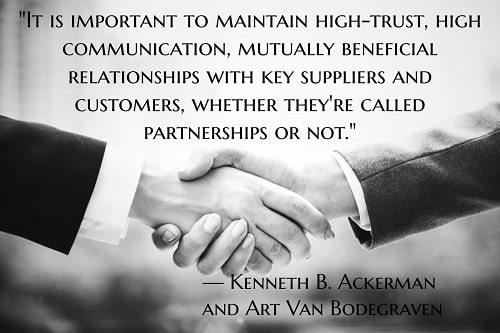
7. Focus on building collaborative relationships with your colleagues. “…it is important to maintain high-trust, high communication, mutually beneficial relationships with key suppliers and customers, whether they’re called partnerships or not. Granted, there are some very successful mega-merchants that are able to dictate prices, terms, and processes to their suppliers by threatening to pull their business. But the fact is that very few of us are in the position of being able to tell our suppliers, ‘My way or the highway.’ For the rest of us, creating and developing strong, positive relationships is a key to supply chain success.” — Kenneth B. Ackerman and Art Van Bodegraven, Relationships for Supply Chain Success, CSCMP’s Supply Chain Quarterly; Twitter: @TheQuarterly
8. Encourage managers to be transparent. “Talk to your team about where they’re encountering bottlenecks. If you or your buyers are spending a disproportionate amount of time with some suppliers to the neglect of others, you can intervene as needed to remove roadblocks or reallocate resources.” — Katy Jones, 4 Communication Tips for Better Supply Management, FoodLogiQ; Twitter: @FoodLogiQ

9. Develop a communication chain. “A chain of communication is as straightforward as it sounds, but it is important to establish the expected flow of information within a business. The chain can be as simple as the chain of command, but all members must understand what is expected of them when they receive a message — including what messages should be forwarded, who they should be forwarded to and how they should be delivered.” — Why Do Supply Chain Need an Effective Communication Plan?, River Logic; Twitter: @RiverLogic
10. Optimize supply chain optimization by keeping stakeholders and suppliers in the loop. “Regularly meet with stakeholders and suppliers. By getting together with them on a regular basis (weekly for instance) you can highlight and tackle their concerns and worries as they occur. Don’t be scared to over-communicate, make sure they are regularly updated even if it’s just a quick summary email. With suppliers it’s also important to regularly asses how you can improve your relationship from both sides, and offer constructive feedback to the supplier as well as asking for it yourself.” — Why Communication is Key to Your Supply Chain Success, Oxford College of Procurement and Supply; Twitter: @Procure_Supply
Important quality control tips
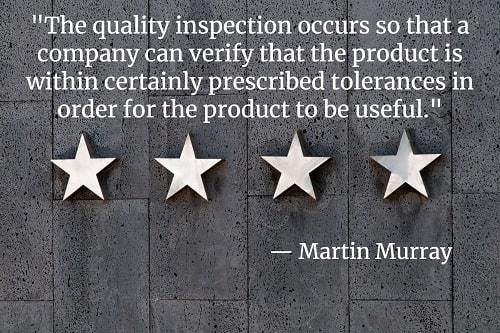
11. Perform quality inspections on all purchased items. “The quality inspection occurs so that a company can verify that the product is within certainly prescribed tolerances in order for the product to be useful. For example, a company may purchase a paint additive to be used in their manufacturing process, but before it can be used, it has to be inspected to see that the chemical and physical composition of the additive is within the tolerances to be used in the process.
“When a purchasing agreement is made with a vendor, it will define the characteristics of the product that are to be inspected and the tolerances that would be allowed. If the item is received and found to have characteristics outside those agreed upon in the purchasing contract, then the company can have the ability to return the item to the vendor.” — Martin Murray, Quality Inspections in the Supply Chain, The Balance Small Business; Twitter: @thebalance
12. Be proactive about spotting counterfeit materials within your supply chain. “Counterfeiting is big business. According to Electronics Weekly, current estimates have at least two percent of electronics components worldwide to be counterfeits. Knowing how to identify counterfeit parts is helpful. Rigorous planning and oversight of vendor selection criteria, engineering controls, component sampling, inspection and testing is key, too.” — Supply Chain Management Tips, Travelers; Twitter: @Travelers
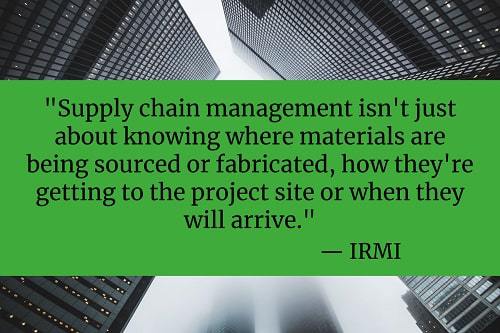
13. Get in the habit of asking the important questions. “Supply chain management isn’t just about knowing where materials are being sourced or fabricated, how they’re getting to the project site or when they will arrive. It’s knowing these things within the context of your project specs and requirements that’s the key for risk mitigation planning (RMP), particularly when the subcontractor is smaller in size and/or if it’s the first time you’re working with them.
“Is the subcontractor using the right raw materials? Are products being manufactured to job specifications? Can you inspect a sample? Is what’s being produced the same as what was ordered? Did the job ship? Can we see the purchase order confirmation? That’s the depth you need to go to verify that what you’ve been promised verbally is what’s being done.” — Supply Chain Quality Management: Control it Before it Controls You, IRMI; Twitter: @IRMIowl
14. Take an in-depth look at your supplier’s practices. “Software is not enough. Obviously the importer needs to negotiate a certain level of visibility and access to the critical sub-suppliers, and needs the exporting factory to be open about their internal processes.” — Supply Chain Management: The Role of Quality Inspections, QualityInspection.org
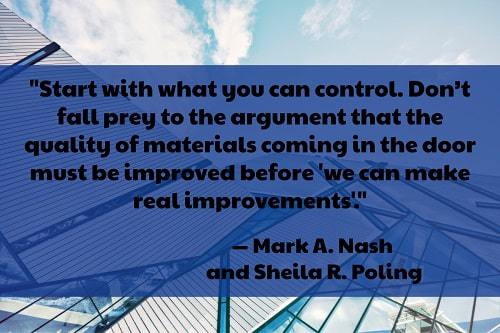
15. Take personal responsibility for your own role in quality. “So where should you start to improve quality throughout the supply chain? How about starting with you? Whoever you are, whatever your job is, this is where it starts. After all, for most of us there is no way to correct all of our issues at once. So why try? Start with what you can control. Don’t fall prey to the argument that the quality of materials coming in the door must be improved before ‘we can make real improvements’.” — Mark A. Nash and Sheila R. Poling, Management: Supply Chain Quality Begins with You, Quality Magazine; Twitter: @QualityMagazine
16. Improve supply chain optimization, by being consistent in your quality control practices — even when you’re under pressure. “You’re about to hit line-stop and a company you’ve never heard of before are offering the stock you need. But before you send across the purchase order what do you really know about them? What impact could this part have on your product and reputation should it turn out to be suspect? What does your gut instinct tell you? It’s usually right…” — Danielle Olivier, How to Prevent Suspect Components from Entering Your Supply Chain, JJS Manufacturing; Twitter: @jjsmfg

17. Compare your risk management plan to your supplier quality audits. “With companies being held to increasingly high quality standards, supplier quality audits play a pivotal role in ensuring that the products delivered by suppliers meet pre-defined quality specifications. However, instead of trying to audit all suppliers at once, it is much more efficient to classify suppliers by risk, and then prioritize audit activities accordingly. Generally, suppliers that are high risk are those that are critical to your product’s availability and quality, and therefore, require more frequent on-site audits to ensure that they have adequate quality controls and measures. Lower risk suppliers are those that have no direct product impact, and therefore require fewer audits.
“Once all suppliers have been assessed and classified based on risk, plan and schedule audits to identify quality gaps, issues and opportunities for (supply chain) optimization. Also, instead of using audits as a chance to police and punish suppliers, create a positive experience help suppliers understand the importance of the audit, give them the time to respond to queries, and work with them to address identified issues.” — Best Practices in Supplier Quality Management, MetricStream; Twitter: @metricstream
18. Establish a quality control standard prior to making agreements with suppliers. “First and foremost, establish exactly the quality you’re looking for. Have a list of materials and standards you’re willing to compromise on, and those you’re not. Is price more important to you, or super-high quality? Establishing all your expectations first will give you a good base to start researching. Also, it will help you eliminate, right away, suppliers that simply can’t meet your standards for any number of reasons.” — Crystal Gilliam, Are Your Suppliers Giving You Their Best?, TradeGecko; Twitter: @TradeGecko
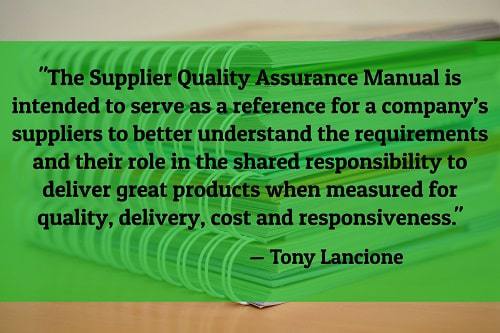
19. And, once your standard is established, put it in writing. “The Supplier Quality Assurance Manual is intended to serve as a reference for a company’s suppliers to better understand the requirements and their role in the shared responsibility to deliver great products when measured for quality, delivery, cost and responsiveness. This manual contains several documents that include expectations and working procedures to assist your supply partners in reaching premium supplier status.” — Tony Lancione, Supplier Quality 101: Key Processes & Measurements for Success, Industry Star; Twitter: @industrystarllc
20. Get to know the difference between ‘quality assurance’ and ‘quality control’. “According to the American Society for Quality (ASQ), ‘Quality assurance consists of that ‘part of quality management focused on providing confidence that quality requirements will be fulfilled.’ The confidence provided by quality assurance is twofold — internally to management and externally to customers, government agencies, regulators, certifiers and third parties. Quality control is that ‘part of quality management focused on fulfilling quality requirements.’ While quality assurance relates to how a process is performed or how a product is made, quality control is more the inspection aspect of quality management.” — 5 Quality Assurance Best Practices for Manufacturers, OptiProERP; Twitter: @optiproerp
Price negotiation strategies
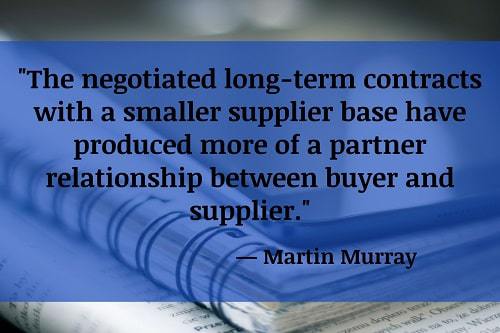
21. You can optimize your supply chain by negotiating your long-term contracts as partnerships. “The negotiated long-term contracts with a smaller supplier base have produced more of a partner relationship between buyer and supplier. The relationship can become less adversary which benefits buyer and vendor. In a partner type of relationship, the buyer will encourage the vendor to increase quality and service, and the vendor knows that by doing this the partnership will continue with a renewed contract with guaranteed sales.” — Martin Murray, Negotiation in the Purchasing Process, The Balance Small Business; Twitter: @thebalance
22. Demonstrate your added value to powerful suppliers. “The quickest and least expensive way to redress a power imbalance is to offer the supplier a market opportunity that is too good to pass up in exchange for price concessions. Finding the right carrot can take some digging. Here’s a case in point: A beverage company was facing annual price hikes from a beverage-packaging supplier. It seemed to have no way out; the supplier had patented its manufacturing process, and its pricing was lower than that of other sources.
“But as it happened, the buyer was about to enter two large developing markets in which the supplier had tried but failed to gain traction. The procurement manager realized that the company could give the supplier’s products a foothold in those markets. She and her team put their heads together with the marketing team and presented the supplier with an offer that was hard to refuse: In exchange for a 10% price reduction globally, the company would use the supplier’s cans in the new markets.” — Petros Paranikas, Grace Puma Whiteford, Bob Tevelson and Dan Belz, How to Negotiate with Powerful Suppliers, Harvard Business Review; Twitter: @HarvardBiz
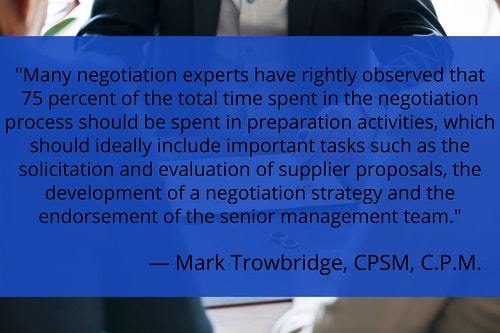
23. Come into negotiations as prepared as possible. “Inventor Thomas Edison is quoted as having once said, ‘A genius is just a talented person who does his homework’. Many negotiation experts have rightly observed that 75 percent of the total time spent in the negotiation process should be spent in preparation activities, which should ideally include important tasks such as the solicitation and evaluation of supplier proposals, the development of a negotiation strategy and the endorsement of the senior management team.” — Mark Trowbridge, CPSM, C.P.M., Principal at Supply Management Consultancy Strategic Procurement Solutions, Seven Techniques for Preparing Negotiations with Your Key Suppliers, Supply Chain 247; Twitter: @SupplyChain247
24. Focus on your leverage. “…too many people are tempted to think of leverage as something they either have or they don’t; in other words, they see power as a product of the situation, not as the result of actions they can take. Just like moving the seesaw board forward or backward over the fulcrum to change the dynamic on the playground, there is much either side can do to find, build and develop leverage in any negotiation. By thinking more creatively, negotiators can find a wider range of leverage opportunities. Like most tools, the challenge is to pick the right one for the job: With the right tool, the work gets done faster and with greater success.” — Frank Mobus and Brad Young, Supply Chain Negotiations: Creating Leverage, Supply Chain Management Review; Twitter: @SCMR

25. Get to know your potential supplier. “Taking steps to understand a supplier’s organization as closely as possible — their cost base, products, market and competitors — will facilitate a more constructive discussion and help to secure a mutually-beneficial agreement. During negotiations, it is important that businesses maintain an emphasis on supplier performance, ensuring that partners are able to deliver the right value, on time and whilst making appropriate efforts to mitigate supply chain risk. As well as establishing a mutual, long-term commitment to achieve certain objectives — for example, to facilitate cost efficiencies or improve production methods — buyers should be able to address quality, transactional and performance-related issues honestly and openly.” — Paul Adams, Management Consultant and Industrial Sector Specialist at Vendigital, Three Steps to Negotiation Success, Supply Management; Twitter: @supplymgmt
26. Use the negotiation to show authenticity and build trust. “One guiding principle that is too often neglected in modern negotiation is authenticity. Many people enter into negotiation looking to gain a competitive advantage by concealing information or through outright deceit. While you may achieve a particular desired result through such practices in the short term, you run the risk of tarnishing both your company’s and your own reputation, as well as increasing the odds of a fraudulent inducement claim should the deal go bad.
“A much better practice is to be honest and authentic. By making it clear that you are a straight shooter who deals in good faith, you are more likely to disarm the other side’s natural defense mechanisms and improve the odds of a productive, long-term business partnership. Moreover, you are creating career insurance for yourself, as companies are far more likely to hire and retain employees who have a reputation for honesty and sincerity over doubletalk and trickery.” — Patrick Burnson, Executive Editor for Logistics Management and Supply Chain Management Review, Five Useful Guidelines for Successful Negotiating, Supply Chain Management Review; Twitter: @SCMR

27. Compile a negotiation team that is well-matched to the supplier. “Once you’ve set out your strategy, it is also essential to get your negotiating team right. Make sure it has skills in all the necessary areas. You’ll need to ensure you match the seniority of the supplier’s representatives. For example, you shouldn’t send a junior account manager to bargain with their managing director. Make sure each member of the team is familiar with your negotiating strategy. The more confident they sound about what they want, the more likely they are to get it.” — Negotiate the Right Deal with Suppliers, Info Entrepreneurs; Twitter: @Acclr_CCMM
28. Have a deposit ready go into the negotiation. “To create leverage with a supplier, have a deposit of at least 50% ready to go. The more of a down payment you’re willing to make, the better your negotiating power will be. Suppliers are just as concerned about getting paid as you are and addressing the issue up front helps them see you are a customer worth working with. Having a deposit available is critical if you’re a new company and don’t have much of a track record in working with suppliers you can use as a reference.” — Rob Biedron, Negotiation Tips for Dealing with Suppliers, PurchaseControl; Twitter: @purchasecontrol

29. Research outside of the box. “Take the time to research any market data for the supplier’s industry, specifically looking for trends in the market that could influence their negotiating position. If their product or service is commodity influenced, pull the pricing indices for the last 1-3 years, as well as any market research or publications regarding future pricing trends. This information can offer you some valuable insight during your negotiations, especially if your supplier has not prepared as thoroughly as you.” — Julie Brignac, Principal, Vantage Partners, Choosing the Best Negotiation Tactics, Managing Americans; Twitter: @ManageAmericans
30. Put yourself in the supplier’s shoes. “Try to determine which products or services are most important to them; many suppliers will try to push certain items in order to bring in product-specific bonuses offered by the vendor’s company. Understanding the internal incentives driving suppliers’ sales teams will help in establishing a mutually beneficial contract.
“If you can identify a way to help the vendor get the incentives they’re after without wasting your own money and resources, your partnership will be more valuable to both parties. In some cases, even just writing a short testimonial for a supplier can bring about discounts for your company.” — Helen Carey, 5 Tips for Successful Supplier Negotiations, Thomas; Twitter: @ThomasNet
Ways to increase your end-to-end visibility
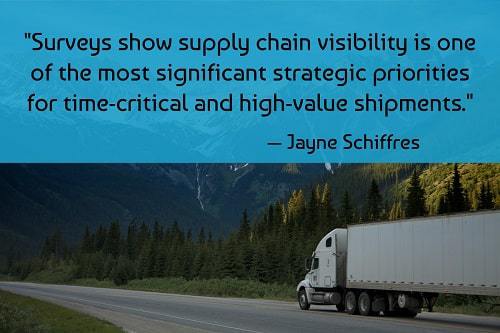
31. Improve supply chain optimization by adopting an automation model that your entire supply chain can access. “Surveys show supply chain visibility is one of the most significant strategic priorities for time-critical and high-value shipments. For this to function correctly, all departments within an organization must work in tandem. Having the ability to utilize a system that can distribute real-time data to all involved is a necessity for tech-enabled logistics providers.” — Jayne Schiffres, How to Increase Your Supply Chain Visibility, AirspaceTechnologies; Twitter: @AirspaceTech
32. Define ‘supply chain visibility’ as it relates to your operation. “Supply Chain Visibility (SCV) should be seen as an end-to-end network from fabrication to delivery that a company can leverage to increase brand awareness and loyalty from customers, give the organization the ability to pivot when changes are required and the foresight to identify problems on the horizon before they become major issues. Define your network from an operational standpoint. How does increased visibility support employee efforts, and how does it align with customer expectations.” — JoeSupplyChain, 5 Ways to Increase Supply Chain Visibility, Medium; Twitter: @joeoliaro

33. Acquire and integrate the necessary data. “End-to-end visibility can dramatically improve an entire supply chain operation. The key to achieving this holy grail is to acquire and integrate the necessary data. Information that allows a business to scale is critical to meeting demand as it arises. Companies can create a demand-driven supply chain if they implement the right solutions and improve oversight through their IT infrastructure.” — Dustin Caudell, 4 Challenges and Solutions for End-to-End Supply Chain Visibility, RFgen; Twitter: @RFgenSoftware
34. Bring on team members who understand the importance of visibility. “New technology enables both new processes and new talent. Recruit people who are analytically inclined and highly skilled at interpreting data.” -— Increasing Supply Chain Visibility, Inbound Logistics; Twitter: @ILMagazine

35. Designate key decision-makers. “It is important to select a decision-maker with accountability for global revenues and profits and key for your supply chain. Also work at investing in internal processes to guide platform management and stock-keeping unit rationalization and simplification.
“Add partnership and interaction through developing strong supplier relationships to rapidly make changes as needed and address all issues. Keep a continual feedback loop through collaboration of members with an on the ground presence to make quick adjustments in culture, issues and local practices to maintain a full range of sight of your entire supply chain. A clear view of the landscape is vital for prevention and mitigation of deadline delays.” — 3 Tactics to Create an End to End Supply Chain Presence for 5 Areas, FlashGlobal; Twitter: @FlashGlobal
36. Use data from the past and present to inform your future. “To succeed supply chains must be nimble, proactive, highly adaptable and transparent from origin to destination. In a perfect world, supply chain leaders would have complete end-to-end supply chain visibility, and be able to continuously monitor the many factors affecting supply chain performance and adjust operations in real time. They would have the business intelligence and analytics based on this data to understand past events, predict future ones and optimize supply chain efficiency and reduce risk for in-transit goods.” — Jim Hayden, End-to-End Visibility Informs Global Supply Chains, Savi; Twitter: @savi360

37. Promote adaptivity throughout your supply chain. “There is a growing trend to achieve transparency in the logistic process which will most likely complicate things even further when it comes to analytics depth and predictiveness. This will not make things easier, and neither will the ever diversifying landscape of tech solutions arising from cloud computing mixing with wearable devices and Internet of Things. Companies will face even more dilemmas over which solution can achieve visibility easier, and can be implemented safely. The competitive advantage of the supply chain will come from the ability to adapt and implement new technologies and mix them together into a personalized data machine seamlessly extracting data from all areas of the organization.” — Matias Honoroto, 3 Important Pillars in Supply Chain Visibility, Beetrack; Twitter: @beetrack
38. Ensure that all features in your visibility map are useful to the users. “Controlling the flows is all about gaining improved visibility into the supply network and using that information to address inefficiencies. To obtain a granular view of the material flowing through the network, a company must create a platform that connects data from multiple systems. It can then feed the data into advanced algorithms that fuel descriptive, predictive and prescriptive analytics. The output is a ‘control tower’ that supply chain managers use to predict and respond to disruptions and inefficiencies in material flows.
“The data and insights provided by the control tower must be tailored to deliver actionable information to each specific user in the supply chain, from end-to-end supply chain managers to employees on the shop floor. A company can use technologies such as wireless sensors and ‘data lake’ architectures to efficiently expand the data set. This enables even deeper insights, better predictive outcomes and additional improvement opportunities.” —Gideon Walter, Frank Cordes, José Rodriguez, Jonathan Lowe and Neeru Pandey, Turning Visibility into Value in Digital Supply Chains, BCG; Twitter: @BCGCareers
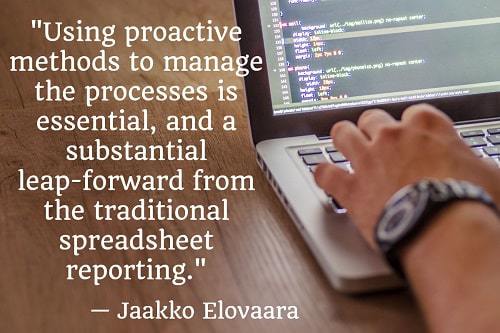
39. Use your good visibility to get a better grasp on compliance. “It is important to keep in mind the increasing amount of global regulation by default, in addition to e.g. supply chain sustainability topics (how to ensure you have a full audit trail in single product level of the facts about the manufacturing, e.g. using child labor).
“Using proactive methods to manage the processes is essential, and a substantial leap-forward from the traditional spreadsheet reporting. Such traditional reporting methods typically come in to play only once negative events have already taken place (hence useless and not helping to resolve anything anymore). Cognitive methods that take a proactive approach are surfacing, but again they need to be integrated to valid data sources, that are usually external.” — Jaakko Elovaara, The Secret to Achieving Full Supply Chain Visibility, Youredi; Twitter: @youredi_tweets
40. Implement tracking tools to keep your suppliers and customers in-the-know. “Relatively inexpensive, cloud-based technology now allows you to have near real-time awareness of when inbound shipments will arrive, so you can gear up as needed or respond quickly to delays that off-put customers. Similarly, technology can let you track when an order has been processed, picked, packed and shipped and send a tracking number to your customer.” — 10 Ways to Improve Your Supply Chain Right Now, UPS; Twitter: @UPS
Secondary and contingent supplier planning
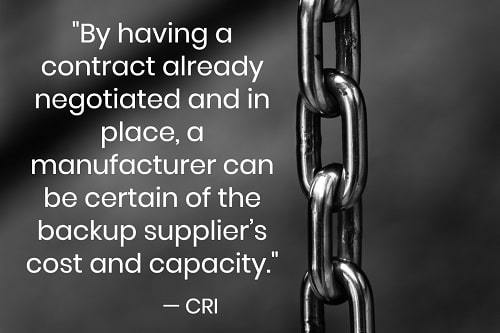
41. Devise a ‘mutual aid’ agreement. “By having a contract already negotiated and in place, a manufacturer can be certain of the backup supplier’s cost and capacity. To further round out potential risks, manufacturers should consider choosing backup suppliers from different regions so that local material shortages and disasters will be less likely to impact order fulfillment. Manufacturers should also consider asking primary suppliers to create a ‘mutual aid’ agreement with partner companies to supplement shortages. Finally, explore the possibility of requiring suppliers to have business continuation insurance, equipment breakdown coverage and other insurance to help reduce the likelihood of a halt in order fulfillment.” — Backup Suppliers are a Link to a Strong Supply Chain, CRI; Twitter: @CRIcpa
42. Assemble a designated contingency planning team. “Establish a team that will be responsible for making decisions during a crisis, and communicate it throughout the supply chain. When communication channels break down, people often act and react on their own, thinking that they are doing the right thing, when in fact it may hurt the overall plan.” — Supply Chain Contingency Planning: 12 Tips for Weathering the Storm, J.P. Morgan; Twitter: @jpmorgan
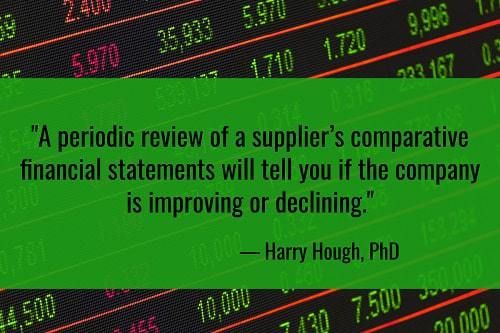
43. Keep track of your supplier’s health. “A periodic review of a supplier’s comparative financial statements will tell you if the company is improving or declining. Companies cannot indefinitely decline without eventually closing their doors. Make sure you let your suppliers know that you want to be kept informed. Put a clause in your contract requiring thirty or sixty days or more notice before any closure.” — Harry Hough, PhD, founder of the American Purchasing Society, Always Have a Backup Supplier Ready, Purchasing and Negotiation Training
44. Plan for disruptions. “Another great strategy to protect against a supply chain failure is developing a backup supply. The idea is that a company identifies an acceptable supplier and enters into an agreement to reserve production capacity for a potential need during a disruption. This is like a diversified supply strategy, but different in one key aspect: it’s cheaper. This is because cost is only incurred when the supply source is engaged during the disruption event. When leveraging a diversified supply chain, the company must absorb the costs associated with maintaining multiple supply sources, even when a disruption risk may not be present.” — 5 Strategies to Protect Against Supply Chain Disruption, Industry Star; Twitter: @IndustryStarLLC
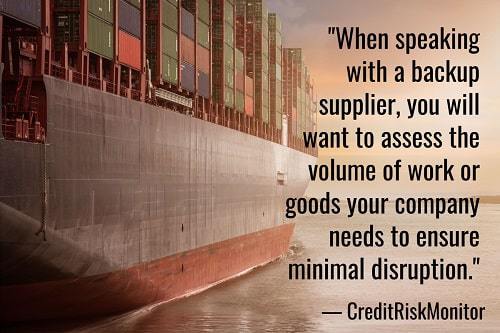
45. Be specific when reaching out to backup suppliers. “When speaking with a backup supplier, you will want to assess the volume of work or goods your company needs to ensure minimal disruption. For instance, if the critical supplier is responsible for the company’s servers, knowing how much data runs through the backup servers will assist the transition.
“One backup provider might claim they can transfer 75% of the server data in a matter of hours, while another potential partner acknowledges that it would take them days to handle 50% of your needs. This is precisely the decisive information that will help determine which backup option is best.” — Minimize Disruption in Your Supply Chain: Design and Implement Your Plan B, CreditRiskMonitor; Twitter: @CreditRiskMon
46. Optimize your supply chain by looking into the reputation of the secondary supplier. “When it comes to finding a secondary supplier, often their best ability is availability. Do they have a reputation for doing whatever it takes to get the job done? Are they flexible enough to be responsive to your needs, especially after an unforeseen impediment jeopardizes your on-time production schedule? Will they work with you to ensure seamless quality, consistency and fulfillment? Seeking out honest answers to these questions will help you determine the fit and future of a secondary sourcing partnership.” — Matt Bishop, 3 Reasons Why Manufacturers Should Work with Secondary Sourcing Partners, Kaysun; Twitter: @KaysunCorp
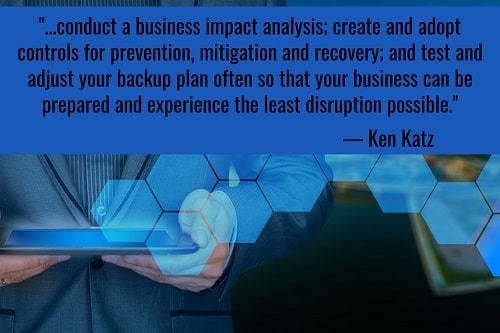
47. But, don’t rely solely on your secondary and contingent suppliers. “…conduct a business impact analysis; create and adopt controls for prevention, mitigation and recovery; and test and adjust your backup plan often so that your business can be prepared and experience the least disruption possible.” — Ken Katz, National Property Director of Risk Control for Travelers, Supply Chain Management: What Small Businesses Need to Know, Business News Daily; Twitter: @BNDarticles
48. Plan according to regions. “Don’t rely on one source for materials or products. It’s desirable to source from low-cost locations around the world, but if goods can’t be delivered in a timely manner, your supply chain becomes vulnerable. Establish reliable secondary suppliers in different regions to minimize this risk.” — Dave Zamsky, Vice President/Sales & Marketing at UPS Capital, 10 Tips to Mitigate Supply Chain Risk, Inbound Logistics; Twitter: @ILMagazine
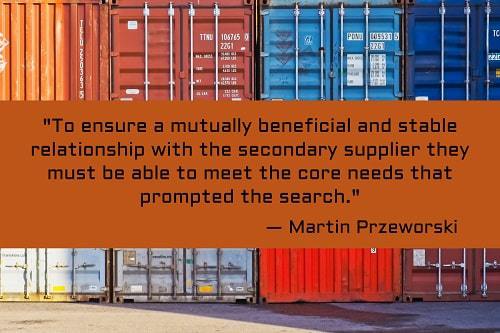
49. Be transparent with your secondary supplier. “To ensure a mutually beneficial and stable relationship with the secondary supplier they must be able to meet the core needs that prompted the search. The most common reason to seek and develop a secondary source relationship with a supplier is simply to alleviate the risks associated with production interruptions due to complete dependence on one supplier for a portion of the component materials or assembly services. However, manufacturing capabilities can also limit the current supply base and cause shortages in supply where the manufacturer or fabricator is not able to meet volume requirements consistently. This can also include variability in quality.” — Martin Przeworski, Finding the Right Secondary-Source Supplier, Strategic Sourcerer; Twitter: @GetSavings
50. Always keep your second-tier suppliers in the loop (to improve supply chain optimization). “First-tier suppliers can take most relationship management off of a company’s plate in dealing with lower tiers. However, this also means companies are dependent upon relationships over which they have little. If things go south between a first-tier supplier and a second-tier supplier, your business may bear the brunt of the fallout. Direct contact with second-tier suppliers can minimize this. It can also be useful when sourcing materials for engineer-to-order jobs that are outside of your usual supply relationship.” — Aaron Continelli, Do You Have Good Relationships with Reputable Second-Tier Suppliers?, Manufacturing.net; Twitter: @MnetNews
Interested in more? Let’s discuss the solution that’s right for you. Contact us today.

